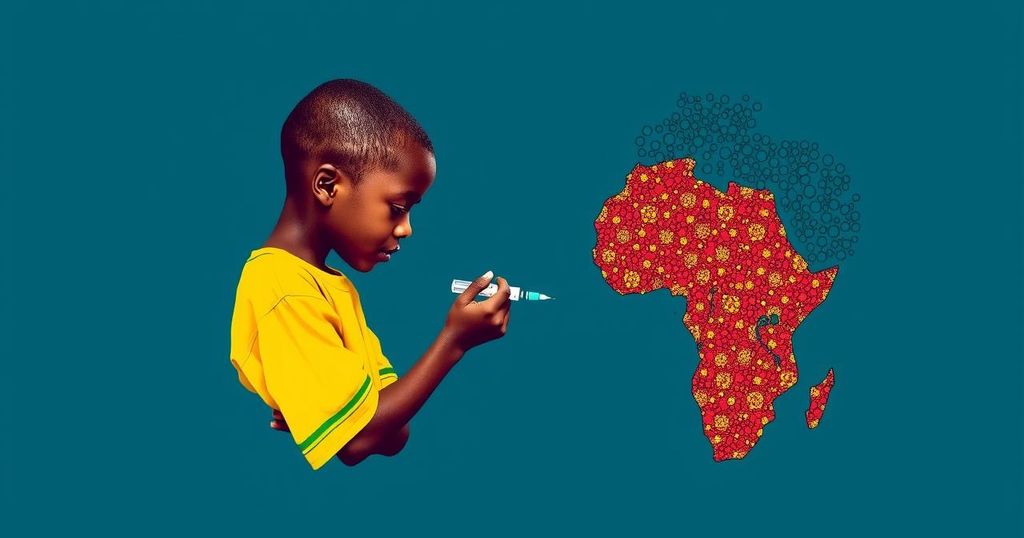Kenya and Uganda Unite in Synchronized Polio Vaccination Campaign, Protecting 6.5 Million Children
A synchronized polio vaccination campaign in Kenya and Uganda from October 3 to October 6, 2024, successfully immunized more than 6.5 million children in high-risk cross-border areas. The initiative responds to recent detections of polioviruses in both countries and underscores the need for collaboration to prevent the virus’s spread. Health authorities emphasized the critical nature of reaching every child in vulnerable communities, highlighting that polio knows no borders and requires unified efforts for eradication.
Between October 3 and October 6, 2024, a successful synchronized polio vaccination campaign took place, reaching over 6.5 million children across Kenya and Uganda. The initiative was launched simultaneously in Bungoma District, Kenya, and Mbale District, Uganda, targeting high-risk cross-border regions. By synchronizing the vaccination dates and sharing real-time information, health officials from both countries effectively immunized children under the age of five, thus diminishing the likelihood of transmitting the poliovirus across their borders. This collaborative effort emerged due to recent detections of poliovirus in both nations, with Kenya reporting six cases in 2024 and Uganda observing one case through environmental surveillance. The underlying philosophy of this initiative underscores the belief that no child should remain unprotected merely due to geographic proximity to an international boundary. Dr. Daniel Kyabayinze, the Director of Public Health in Uganda’s Ministry of Health, stated, “Our health workers will vaccinate every child against polio door-to-door. Vaccination has eradicated many diseases in Uganda. We thank all our partners for their support in ensuring a polio-free future. Protect your children from paralysis & vaccinate today.” Health authorities have successfully implemented strategies that not only operate at national levels in both countries but also across 10 districts along the border, encompassing a combined distance of 772 kilometers. Dr. Yonas Tegegn Woldemariam, the WHO country representative in Uganda, emphasized the critical situation, noting, “The virus is spreading fast in the East African region putting our children – particularly aged 5 years or below at the risk of contracting this incurable yet vaccine-preventable disease.” In response to the spread of the virus, comprehensive micro planning was undertaken to map cross-border populations, migratory patterns, and key entry and exit points between the two countries. Charles Korir, the Global Polio Eradication Initiative Coordinator in Kenya, confirmed, “The Current Polio outbreak in Eastern Africa is fueled by heavy movement of high-risk populations between countries. The decision by the Governments of Kenya and Uganda to conduct two synchronized in October 2-6 and November 6-10 is a laudable effort supported by the GPEI partnership.” This initiative forms part of broader efforts facilitated by the WHO and its GPEI partners, aiming to bridge immunization gaps and address the challenges posed by “zero-dose” children, who have never been vaccinated. Both nations recognized that polio eradication is not achievable in isolation; their cooperative efforts serve as a testament to how regional collaboration can effectively attain public health objectives. The porous nature of international borders heightens the risk of polio transmission, particularly among mobile populations residing in remote areas. Consequently, coordinated vaccination campaigns between neighboring countries are critical for achieving comprehensive immunization coverage and mitigating the risk of paralysis due to the virus. The synchronized approach adopted by Kenya and Uganda not only safeguards the health of their communities but also enhances global health security by preventing the poliovirus from disseminating beyond their borders. This collaboration stands as a model for other countries confronting similar challenges, reinforcing the imperative of synchronized cross-border vaccination efforts to advance towards a polio-free future.
The recent synchronized polio vaccination campaign in Kenya and Uganda highlights the urgent public health challenge posed by polio, particularly at borders where population movements can exacerbate the risk of transmission. The World Health Organization and the Global Polio Eradication Initiative support such collaborative programs, aiming to immunize vulnerable populations effectively. The campaign reflects a phased approach to managing health threats in regions at risk of outbreaks, especially with recent detections of poliovirus.
In conclusion, the synchronized polio vaccination initiative conducted in October 2024 by Kenya and Uganda is a commendable example of cross-border collaboration in public health. This effort not only aims to protect millions of children from the poliovirus but also emphasizes the importance of regional cooperation in addressing health challenges. By prioritizing synchronized vaccination efforts, both nations demonstrate a strong commitment to eradicating polio and safeguarding their populations, ultimately contributing to global health security.
Original Source: reliefweb.int




Post Comment